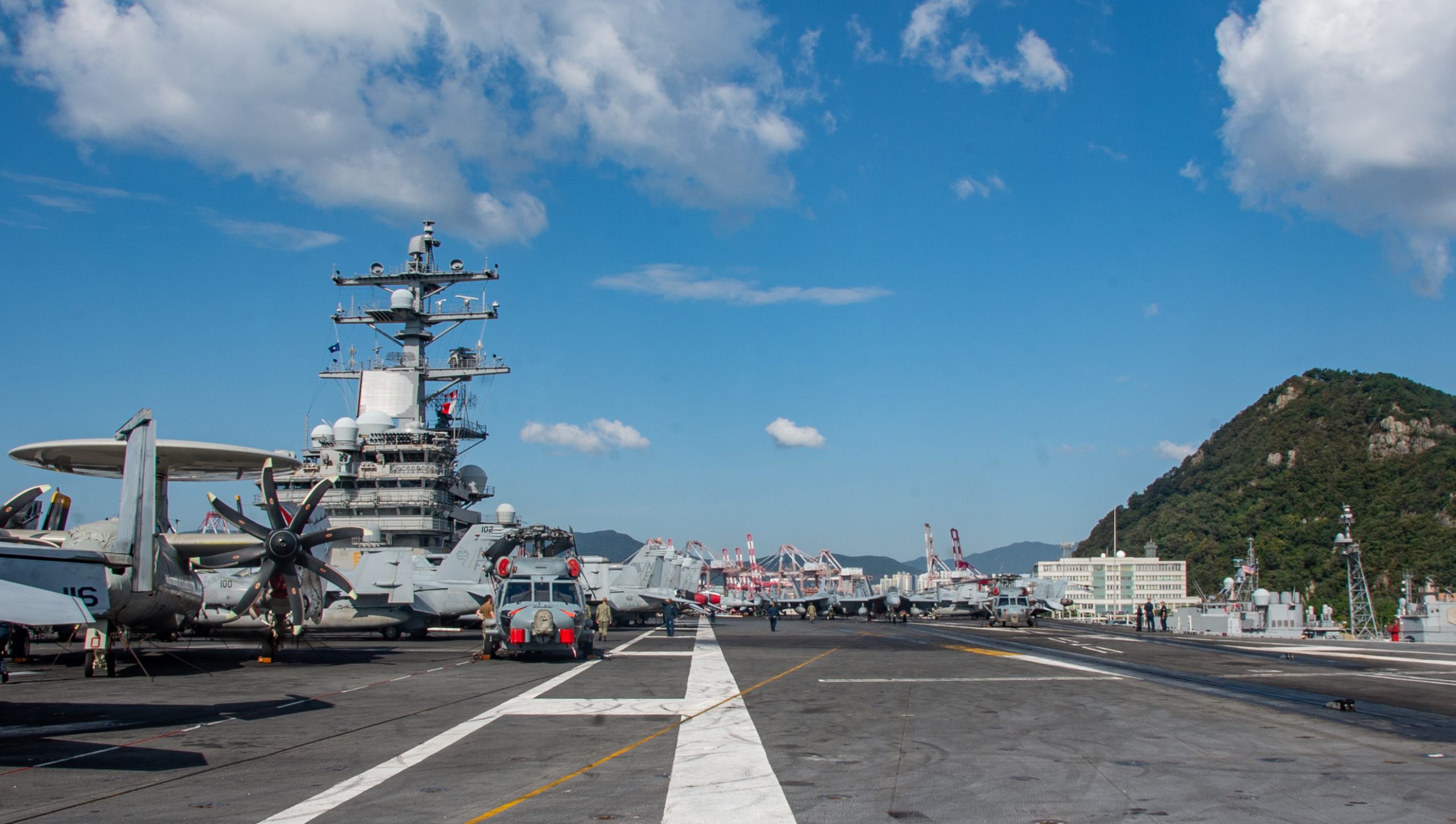
The Ronald Reagan Carrier Strike Group (CSG) conducted drills with a Japan Maritime Self-Defense Force (JMSDF) frigate in the East China Sea from earlier this week, and Russian bombers flew off the coast of Japan on Tuesday. Meanwhile, China is pushing back on claims its fighter jet harassed a Royal Canadian Air Force (RCAF) maritime patrol aircraft (MPA) conducting a mission near North Korea.
The Reagan CSG, comprised of carrier USS Ronald Reagan (CVN-76), cruisers USS Antietam (CG-54) and USS Robert Smalls (CG-62) and destroyer USS Shoup (DDG-86), conducted tactical exercises with frigate JS Noshiro (FFM-3) in the East China Sea from Monday to Wednesday according to a Thursday JMSDF release.
“We will continue cooperating strongly with the U.S. Navy while maintaining a posture to respond to any contingency at any time in order to contribute to regional peace and stability,” said Noshiro’s commanding officer, Cmdr. Masafumi Watanabe.
In the South China Sea, JS Akebono (DD-108) carried out tactical drills with destroyer USS Dewey (DDG-105) and littoral combat ship USS Gabrielle Giffords (LCS-10) from Monday to Wednesday. “Through the exercise, we improved our tactical capabilities and interoperability with the U.S. Navy,” Cmdr. Hisato Togawa, commanding officer of Akebono, said in the release.
Akebono is now on its way to the Gulf of Aden as the 46th Deployment Surface Force Counter Piracy Enforcement (DSPE) Unit, where it will relieve destroyer JS Ikazuchi (DD-107).
On Tuesday, from morning to the afternoon, two Russian Tu-95 bombers accompanied by two Russian fighter aircraft flew in over the Sea of Japan. According to a Joint Staff Office (JSO) of Japan’s Ministry of Defense release, the Russian aircraft headed southeast toward Japanese airspace then turned east off the Noto peninsula on the main island of Honshu. They then flew along the vicinity of Japan’s airspace before turning west off the coast of Oshima Island – which lies off the main island of Hokkaido – flying northwest toward Russia. The Russian bombers and fighters subsequently returned, according to the release, flying over the Sea of Japan and heading eastwards toward Hokkaido before turning north off Okushiri Island, Hokkaido. They flew along the vicinity of Japanese airspace and then turned west off the coast of Rumoi, Hokkaido, to fly back to the Russian continent. Japan Air Self-Defense Force (JASDF) fighter aircraft were scrambled in response, said the release.
 The Russian Ministry of Defense issued a release and video on Tuesday stating that two Tu-95ms strategic missile carriers carried out a scheduled flight in airspace above the neutral waters of Sea of Japan escorted by two Su-35s. “The flight was carried out in strict compliance with international rules on the use of airspace,” said the Сommander of long-range aviation command of the Russian Aerospace Forces, Lieutenant General Sergei Kobylash. “Long-range aviation pilots regularly fly over neutral waters of the Arctic, North Atlantic, Black and Baltic seas, as well as the Pacific Ocean,” concluded the release.
The Russian Ministry of Defense issued a release and video on Tuesday stating that two Tu-95ms strategic missile carriers carried out a scheduled flight in airspace above the neutral waters of Sea of Japan escorted by two Su-35s. “The flight was carried out in strict compliance with international rules on the use of airspace,” said the Сommander of long-range aviation command of the Russian Aerospace Forces, Lieutenant General Sergei Kobylash. “Long-range aviation pilots regularly fly over neutral waters of the Arctic, North Atlantic, Black and Baltic seas, as well as the Pacific Ocean,” concluded the release.
Meanwhile, China’s Ministry of National Defense (MND) is pushing back against claims its fighters harassed a RCAF CP-140 Aurora near North Korea. The CP-140 was conducting surveillance missions against ships violating sanctions as part of the Canadian military’s Operation Neon. Canadian media outlet Global News, which was embarked on the CP-140, released footage of People’s Liberation Army Air Force (PLAAF) intercepting the CP-140 and flying as close as 5 meters to the Canadian aircraft. The report also stated the PLAAF fighters released flares during the intercept. Canadian Defence Minister Bill Blair on Monday stated that the way the intercept was unprofessional, dangerous and reckless, and that Canada would lodge a protest on it.
On Wednesday, MND spokesperson Snr. Col. Wu Qian claimed the Canadian aircraft had repeatedly invaded the airspace of China’s Chiwei Island (China’s name for Taisho Island), which is part of the disputed Senkaku Islands claimed by China and Taiwan but held by Japan.
He added that the PLAAF conducted verification and identification in accordance with Chinese laws and relevant international rules and that the actions were reasonable, legal, professional and standardized. “Canada’s actions seriously infringe upon China’s sovereignty and threaten China’s national security. They can easily lead to misunderstanding and misjudgment, are egregious in nature, and are extremely dangerous. China strongly condemns this and lodges stern representations with Canada,” said Wu.
China has had a history of unsafe intercepts – with the Pentagon disclosing recent incidents on Tuesday – and of conducting intercepts over what it claims are sovereign territories but are not internationally recognized, such as the Spratly Islands and the Senkakus.





